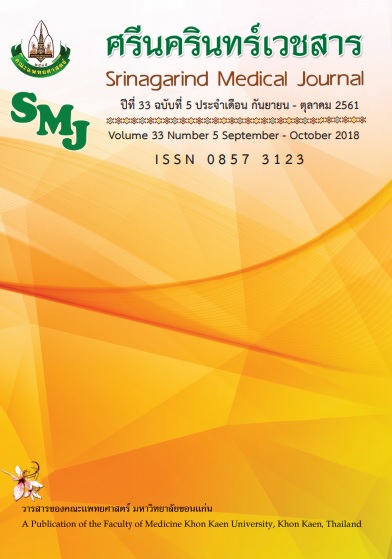Immediate Effects of Loading on the Affected Leg on Functional Abilities in Ambulatory Patients with Stroke
Keywords:
Hemiparesis; Neurology; Walking; Rehabilitation; Physical TherapyAbstract
Background and Objective: Patients with stroke likely have unilateral impairments that affect ability of lower limb loading (LLL) of the affected limb, safety and quality of walking. This study investigated the immediate effects of LLL on the affected limb during stepping training on walking and balance ability in ambulatory patients with stroke.
Methods: This study was a quasi-experimental research. Eighteen participants were repetitively trained for body-weight shifting onto the affected leg during stepping the non-affected leg for 30 minutes, followed by overground walking training for 10 minutes. Participants were assessed for their functional abilities using the 10-meter walk test and timed up and go test immediately before and after training. The dependent samples t-test was used to compare the findings. The level of statistical significance was set at p<0.05.
Results: Most participants were male with an average age of 51±10.9 years old at a chronic stage (89% with an average post-stroke time approximately 3 years). The findings indicated that the participants had significant improvement of walking ability as assessed using the 10-meter walk test and balance ability using the timed up and go test immediately after training (p<0.01).
Conclusion: The LLL training during stepping might promote functional ability of the affected limb. Thus the participants showed better walking and mobility even they were in a chronic stage. The training program can be easily executed in many clinical and community settings. Thus the findings are important, particularly in a current era that the rehabilitation length is dramatically limited.
References
2. Langhorne P, Coupar F, Pollock A. Motor recovery after stroke: a systematic review. Lancet Neurol 2009; 8: 741-54.
3. Yates JS, Lai SM, Duncan PW, Studenski S. Falls in community-dwelling stroke survivors: an accumulated impairments model. J Rehabil Res Dev 2002; 39: 385-94.
4. Alexander LD, Black SE, Patterson KK, Gao F, Danells CJ, McIlroy WE. Association between gait asymmetry and brain lesion location in stroke patients. Stroke 2009; 40: 537-44.
5. Rollnik JD, Janosch U. Current trends in the length of stay in neurological early rehabilitation. Dtsch Arztebl Int 2010; 107: 286-92.
6. Teasell RW, Bhogal SK, Foley NC, Speechley MR. Gait retraining post stroke. Top Stroke Rehabil 2003; 10: 34-65.
7. Hubbard IJ, Parsons MW, Neilson C, Carey LM. Task-specific training: evidence for and translation to clinical practice. Occup Ther Int 2009; 16: 175-89.
8. Eng JJ, Tang PF. Gait training strategies to optimize walking ability in people with stroke: a synthesis of the evidence. Expert Rev Neurother 2007; 7: 1417-36.
9. Mauritz KH. Gait training in hemiplegia. Eur J Neurol 2002; 9 (Suppl 1): 23-9; dicussion 53-61.
10. Wade DT, Wood VA, Heller A, Maggs J, Langton Hewer R. Walking after stroke. Measurement and recovery over the first 3 months. Scand J Rehabil Med 1987; 19: 25-30.
11. Karthikbabu S, Nayak A, Vijayakumar K, Misri Z, Suresh B, Ganesan S, et al. Comparison of physio ball and plinth trunk exercises regimens on trunk control and functional balance in patients with acute stroke: a pilot randomized controlled trial. Clin Rehabil 2011; 25: 709-19.
12. Flansbjer UB, Holmback AM, Downham D, Patten C, Lexell J. Reliability of gait performance tests in men and women with hemiparesis after stroke. J Rehabil Med 2005; 37: 75-82.
13. Verma R, Arya KN, Sharma P, Garg RK. Understanding gait control in post-stroke: implications for management. J Bodyw Mov Ther 2012; 16: 14-21.
14. Pinto EB, Nascimento C, Monteiro M, Castro M, Maso I, Campos A, et al. Proposal for a New Predictive Scale for Recurrent Risk of Fall in a Cohort of Community-Dwelling Patients with Stroke. J Stroke Cerebrovasc Dis 2016; 25: 2619-26.
15. Fulk GD, Echternach JL, Nof L, O'Sullivan S. Clinometric properties of the six-minute walk test in individuals undergoing rehabilitation poststroke. Physiother Theory Pract 2008; 24: 195-204.
16. Podsiadlo D, Richardson S. The timed "Up & Go": a test of basic functional mobility for frail elderly persons. J Am Geriatr Soc 1991; 39: 142-8.
17. Salbach NM, Mayo NE, Higgins J, Ahmed S, Finch LE, Richards CL. Responsiveness and predictability of gait speed and other disability measures in acute stroke. Arch Phys Med Rehabil 2001; 82: 1204-12.
18. Carpio-Rivera E, Moncada-Jimenez J, Salazar-Rojas W, Solera-Herrera A. Acute Effects of Exercise on Blood Pressure: A Meta-Analytic Investigation. Arq Bras Cardiol 2016; 106: 422-33.
19. Eng JJ, Chu KS. Reliability and comparison of weight-bearing ability during standing tasks for individuals with chronic stroke. Arch Phys Med Rehabil 2002; 83: 1138-44.
20. Perennou D. Weight bearing asymmetry in standing hemiparetic patients. J Neurol Neurosurg Psychiatry 2005; 76: 621.
21. Kim CM, Eng JJ. Symmetry in vertical ground reaction force is accompanied by symmetry in temporal but not distance variables of gait in persons with stroke. Gait Posture 2003; 18: 23-8.
22. Dietz V, Muller R, Colombo G. Locomotor activity in spinal man: significance of afferent input from joint and load receptors. Brain 2002; 125: 2626-34.
23. Duysens J, Clarac F, Cruse H. Load-regulating mechanisms in gait and posture: comparative aspects. Physiol Rev 2000; 80: 83-133.
24. Sinkjaer T, Andersen JB, Ladouceur M, Christensen LO, Nielsen JB. Major role for sensory feedback in soleus EMG activity in the stance phase of walking in man. J Physiol 2000; 523 Pt 3: 817-27.
25. Harkema SJ, Hurley SL, Patel UK, Requejo PS, Dobkin BH, Edgerton VR. Human lumbosacral spinal cord interprets loading during stepping. J Neurophysiol 1997; 77: 797-811.
26. Park G-D, Choi J-U, Kim Y-M. The effects of multidirectional stepping training on balance, gait ability, and falls efficacy following stroke. J Phys Ther Sci 2016; 28: 82-6.
27. Wade DT, Hewer RL. Functional abilities after stroke: measurement, natural history and prognosis. J Neurol Neurosurg Psychiatry 1987; 50: 177-82.




